Autodesk Inventor computer-aided design (CAD) software facilitates 3D mechanical design, visualization, simulation and analysis, rendering, and documentation. It has powerful features that provide designers and engineers professional-grade engineering and design solutions. Some of these features include the ability to integrate both 2D and 3D data into the same design environment, making cross-referencing and visualization easy.
It also enables the creation of virtual models, which designers and engineers can use to validate their exact dimensions, functions, and forms before manufacturing even begins. It is considered a valuable tool in CAM/CAE/CAD applications. As Scan2CAD, we’ve discussed its usefulness in several of our blog articles, including AutoCAD vs. Inventor, CATIA vs. Inventor, and SolidWorks vs. Inventor, by pitting it against other CAD software. We have also prepared an Inventor tutorial to help you navigate the user interface as well as learn the basics.
What the comparison articles made clear is the fact that Autodesk has some worthy competitors, some of which outperform it in certain applications. For instance, while Inventor makes the path to be followed when developing a 3D model from a hand-drawn concept slow and a tad difficult, SolidWorks makes it easy and fast. The same can be said about several other features, and that is why this article focuses on the top 5 inventor alternatives, which include:
Table of Contents
Before We Start
Before we discuss the various features that make the Investor alternatives above appear on the list, let’s first briefly provide more details about Autodesk Inventor, which is easily among the most popular 3D CAD software in the market today. And that is not by accident. With a ton of features that appeal to mechanical engineers and product designers, it is easy to see the origin of the popularity. Add to this the fact that its developer, Autodesk, is a force in the CAD industry, offers more credence to Inventor’s reputation.
In terms of cost, Inventor is available in multiple packages:
- Monthly: $260
- Annual: $2,085
- 3 Years: $5,630
- Collection: $2,720 (bundles several Autodesk products together, including AutoCAD, Inventor, Fusion 360, and more professional-grade tools)
As stated earlier, you can use Inventor for simulation and analysis. The software facilitates different types of simulations, e.g., manufacturing process (casting die press forming and molding); mechanical event and continuous event simulations; and finite element analysis (FEA), fluid analysis, and kinematic/dynamic analysis.
Nonetheless, the CAD market is competitive, and other software developers offer products with similar, if not better, features. If you are looking for such products, perhaps because the prices of the packages mentioned are too high, features aren’t appealing enough, or you simply want a non-Autodesk product, read on.
Inventor Alternatives
SolidWorks
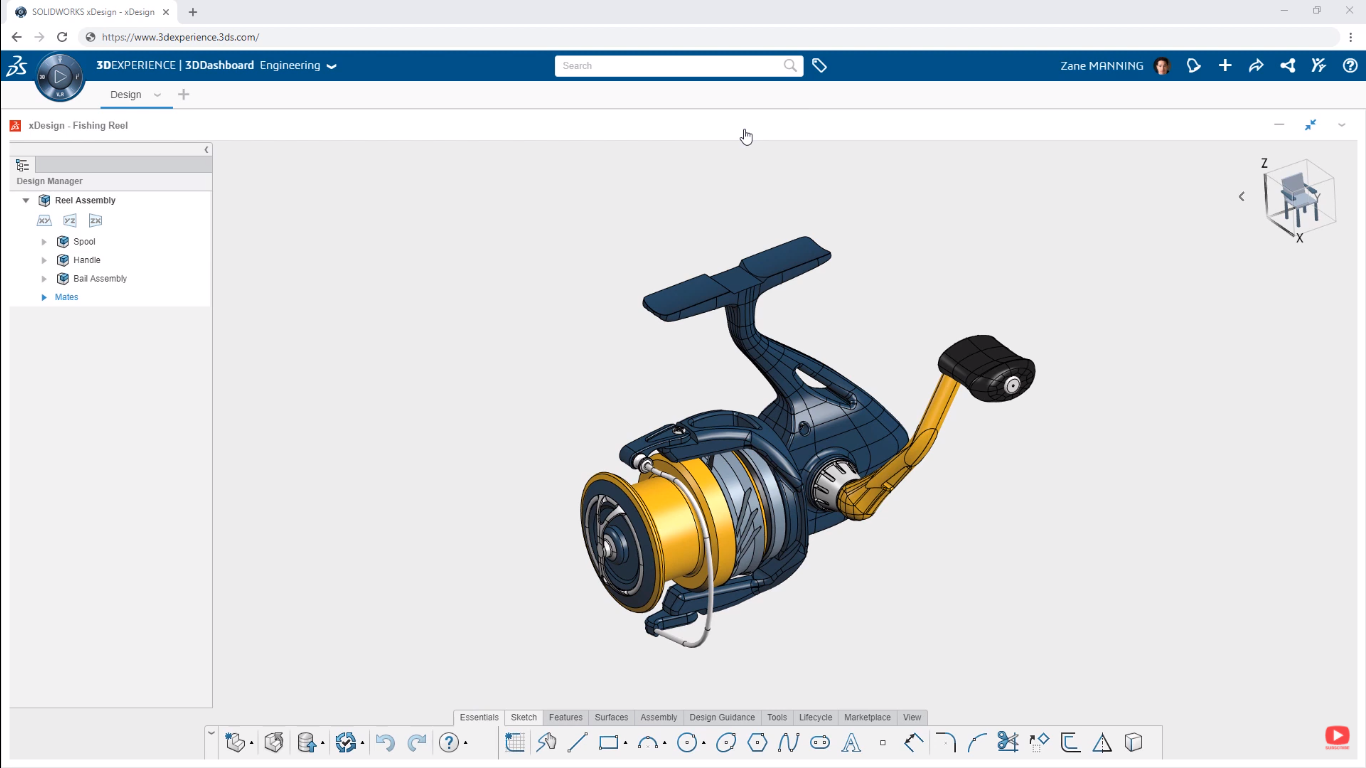
Design Space on SolidWorks (source)
Price: Standard (with one-year subscription service): $5,290.00
Professional (with one-year subscription service): $6,985.00
Premium (with one-year subscription service): $9,990.00
The annual cost of the subscription service, which covers upgrades, technical support, and more, costs $1,295, effectively meaning that SolidWorks licenses are lower than the amounts provided for each package by $1,295.
Supported OS: Windows, Mac OS
Suitable for: Designing and modeling electrical and mechanical elements, simulation (finite element analysis), computer-aided manufacturing (CAM), visualization and visual ideation, prototyping, and feasibility assessment
Features: 3D solid modeling; assembly design; surfacing; welded structures design; mold design; 2D drawings; automation of repetitive tasks; ability to check for clearances, collisions, and interferences between components; collaboration; bill of materials (BOM)
Head-to-Head
SolidWorks (SW) stands out from Inventor because of its advanced assembly function – SW’s is more intuitive. The intuitiveness extends to other areas as well, including the workflow it offers uses and the menu design. It also supports many file formats, meaning that it supports the import or export of files from other CAD software.
Furthermore, SolidWorks is better for large and small assemblies than Inventor, a fact that holds for even older versions of the former when compared to later versions of the latter.
Siemens NX
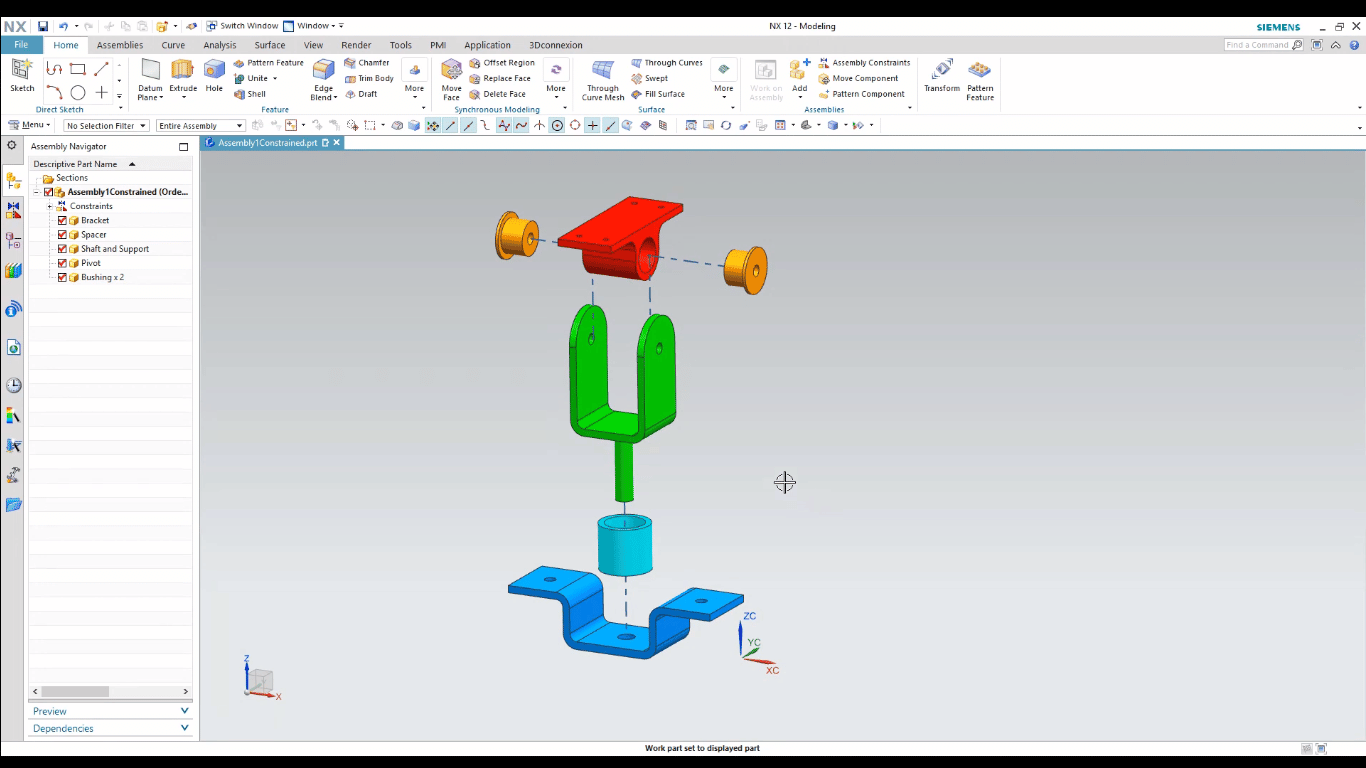
User Interface and Parts Assembly on Siemens NX (source)
Price: NX is available in multiple packages, with the entry-level being about $7,000 per year. The most expensive package (Mach 3 Industrial design) is over $20,000 per year.
Supported OS: Mac OS, Unix, and Windows
Suitable for: modeling (parametric, solid, sheet, surface, and aerodynamic modeling); simulation (thermal, dynamic/vibration, static, and electromagnetic); analysis (finite element analysis and flow analysis); creating 2D drawings (drafting) and 3D designs of complex systems and parts; assembling parts/systems; machining
Features: Integrated CAD, CAE, and CAM functionalities; cost estimation, rendering, and animation; assembly and modeling; documentation and reporting; analysis and simulation
Because it combines CAD, CAM, and CAE functionalities, NX is ideal for mechanical, electrical, and design applications
Head-to-Head
Comparatively, NX is more expensive than Inventor and is mainly used by organizations that can afford the hefty price tag. Nonetheless, it offers plenty of functionalities for users at this price, some of which are better than Inventor’s. For instance, NX’s user experience and user interface are better than Inventor’s. It also provides a better overall experience for organizations and their employees.
It also handles massive assemblies easily, making it extremely useful in the automotive and aerospace industries. It is miles ahead of Inventor for complex applications as it is faster. In fact, users have observed that using NX makes other CAD software in the market seem too simplistic. Nonetheless, for personal projects, Inventor is better because it is cheaper.
CATIA
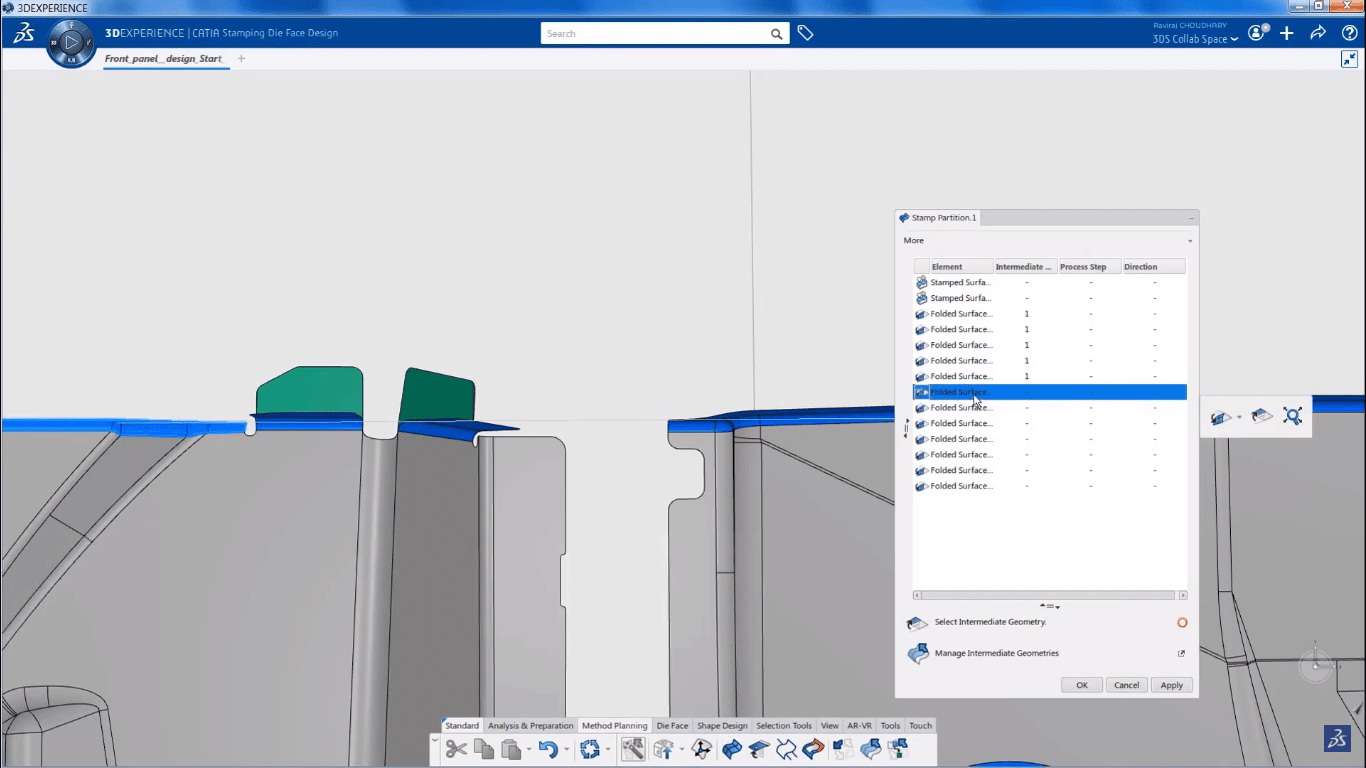
User Interface and Surface Modeling on CATIA (source)
Price: One-time purchase charge of $11,200 plus annual maintenance charge of $2,000
Quarterly lease at $1,700
Yearly lease at $4,500
On pricing, Dassault Systèmes, CATIA’s developer, sells role-based modules at a one-time charge that ranges between $2,700 and $19,000. These modules are geared towards providing additional features to users, depending on the specific function for which they intend to use CATIA.
Supported OS: Windows and some UNIX-based Oss
Suitable for: Design (part design, sheet metal design, mold design, wiring harness design, and more); modeling (surface, solid, and sheet modeling); creating 2D drawings (drafting); billing of materials; analysis (stress analysis, influence of centrifugal forces); assembly and disassembly of parts; simulation (multiple excitations and measures); rendering
Features: Good user interface; advanced Boolean operation; collaboration via the cloud; ability to create custom menus; product modeling and advanced surface modeling
These features and functionalities make CATIA ideal for CAE, CAD, CAM, and systems engineering applications.
Head-to-Head
CATIA’s good user interface makes it user-friendly without compromising on its functionalities. Further, it facilitates surface, solid, and sheet modeling, as well as the assembly and disassembly capabilities, making it perfect for companies in the aerospace and automobile industries. On these points, CATIA is superior to Inventor.
Additionally, CATIA is designed to handle large files. It even promotes global collaboration as it is connected to the cloud. However, it requires a computer with good processing power (CPU and graphics card) and plenty of RAM. Anything other than this makes the software slow. It is worth pointing out that Inventor also has similar system requirements.
If you are in the automotive or aerospace industry, CATIA would be a better option than Inventor.
Rhino3D
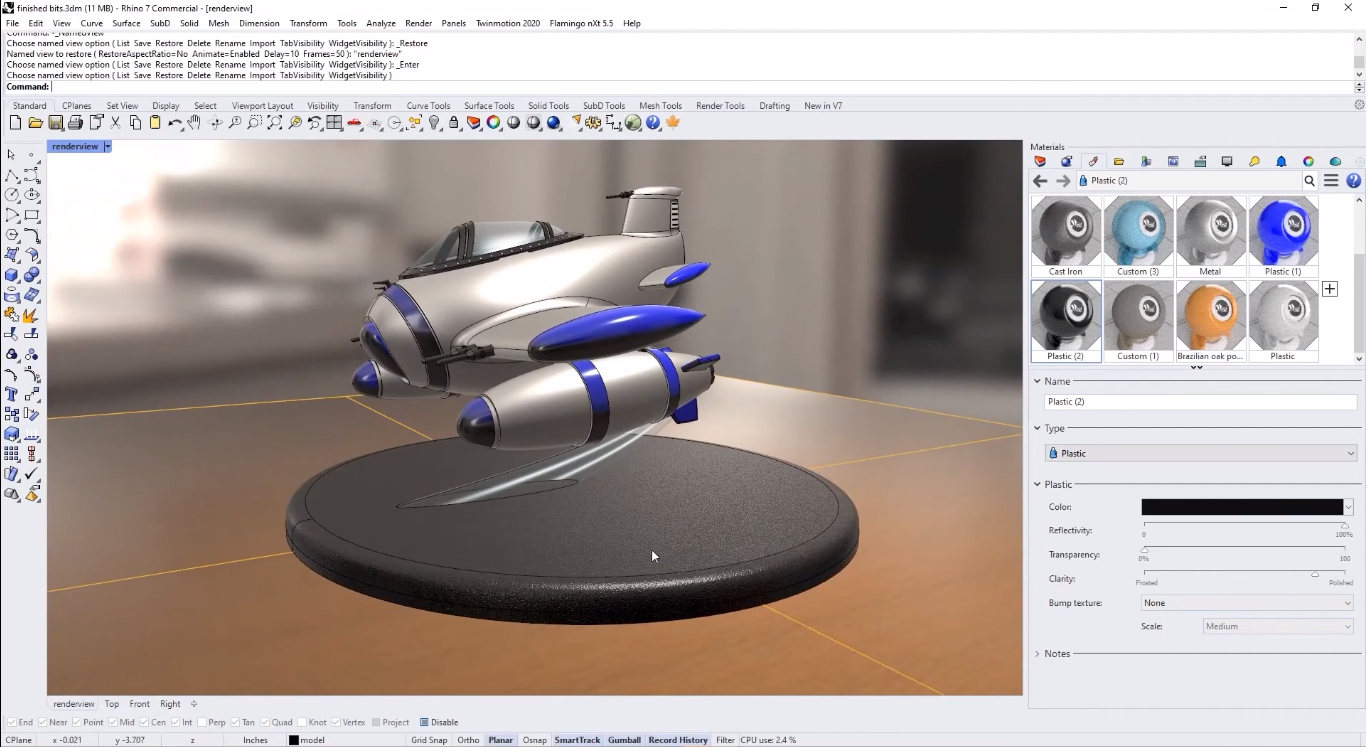
User Interface and Rendering Functionality on Rhino3D (source)
Price: $995 or €995 (This is a one-time price, with no maintenance fees)
Supported OS: Windows and Mac OS
Suitable for: 2D drawing (drafting); analysis; digitizing hardware and scanned objects in 3D; digital fabrication and mold design; rendering and visualization; surface and solid modeling; creating meshes
Features: Command-line-based user experience (but it makes for the need to issue command-line instructions by autocompleting the commands); support for multiple file formats; analysis tools; rendering and presentation tools; unlimited viewports and viewing modes; Boolean operations; modeling tools
Head-to-Head
Rhino3D is comparatively cheaper than Inventor and virtually all the Inventor alternatives discussed above. But at its price point, it still packs a punch. It is ideal for creating 2D drawings as well as 3D models. Further, it offers freedom as users can install various third-party plug-ins to help improve the available functions.
The commands, which are abundant, are simple, making learning and typing them easy. In fact, the software auto-completes the commands. This, coupled with the various features it offers, makes it suitable for beginners intending to get into the 3D modeling software. Nonetheless, it offers fewer features compared to Inventor.
Verdict: Rhino3D is well-suited for personal use, an area in which Inventor also thrives. But because it is cheaper, it is appropriate for beginners looking for affordable software that still offers powerful modeling tools.
Creo Parametric
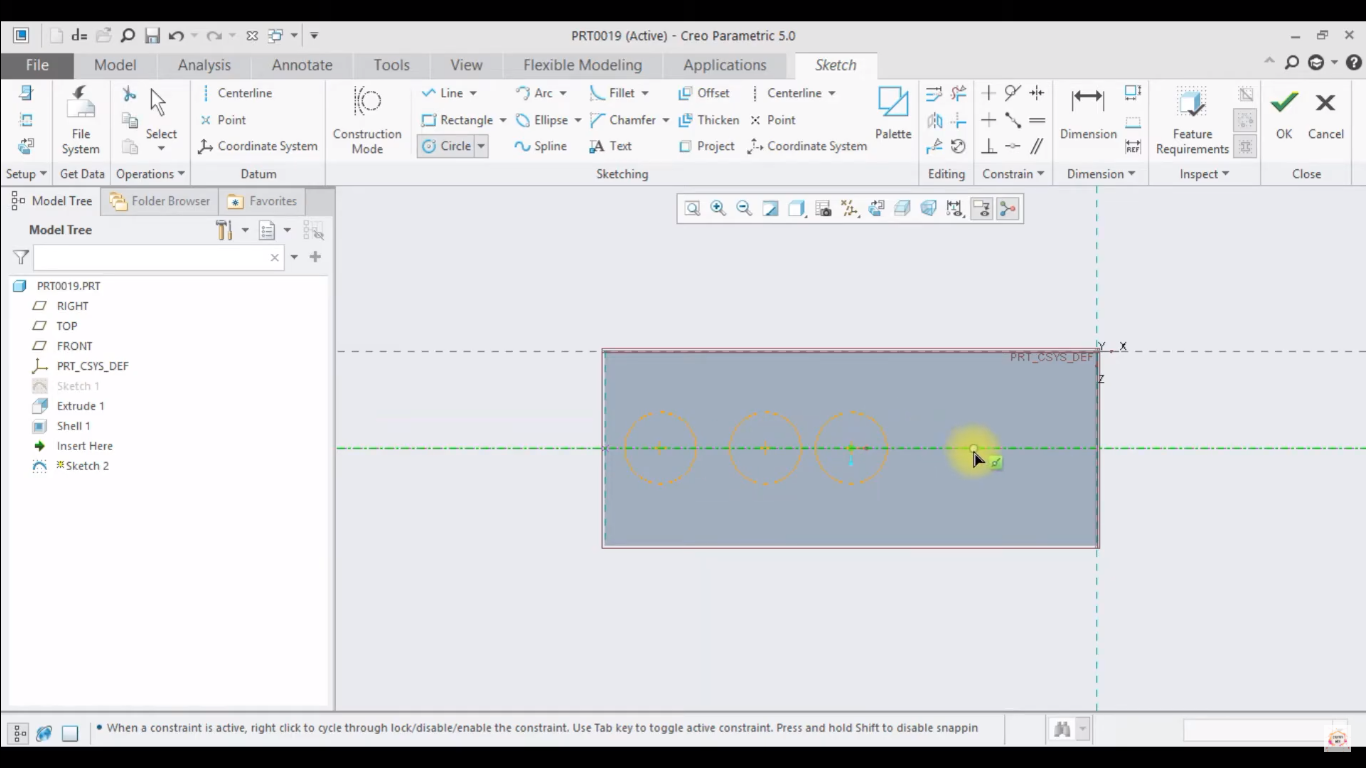
Creo Parametric User Interface (Source)
Price: Essentials: $2,200 – $2,700
Advanced: $3,980 – $4,900
Advanced Plus: $10,300
Premium: $14,375
Premium Plus: $20,000
Supported OS: Windows only
Suitable for: Machining (prismatic production machining, mold machining, production machining) and metal printing; Simulation (liquid and gas flow) and analysis (fatigue, tolerance); creating optimized parametric geometry; surfacing; augmented reality design visualization; assembly design and management; 3D design and 2D drawing; sheet metal design
Features: Augmented reality; additive manufacturing; numerical control (NC) programming capabilities; compatibility with Inventor, SolidWorks, CATIA, and NX native files; tools for surfacing, machining, 3D design, 2D drawing, simulation and analysis, and assembly design
Head-to-Head
Creo is user-friendly as it has a simple user interface as well as commands that are easy to learn. So much so that beginner-level classes are not needed. The fact that it is compatible with a lot of file formats means the importation of drawings is seamless. However, if these files imported contain large assemblies, Creo will struggle to open them.
All in all, Creo can be used to draw any object in 2D and design 3D parts. That said, it is not ideal for recreational 3D modeling as it is primarily designed for professional use – the pricing also points to this fact.
Verdict: Creo is cheaper than Inventor in the long-run because the packages mentioned earlier require one-off payments. If you are looking for recreational 3D software, Inventor would be a better option. However, if you want an easy-to-use CAD software that still offers many of the benefits of conventional CAD software, Creo would be an excellent place to start. Even so, bear in mind that it is not as widely adopted as other software.
Conclusion
The various alternatives differ from each other in many ways. While some offer advanced capabilities that make them perfect for the automobile and aerospace industries, others have fewer features. Also, because these Inventor alternatives are available at different price points, you have a broad pool from which to choose.

